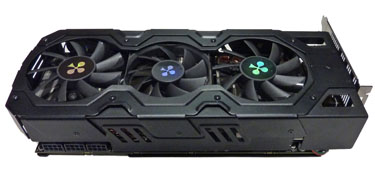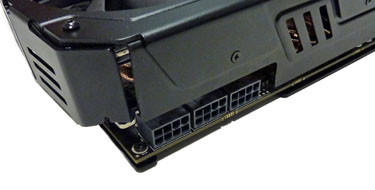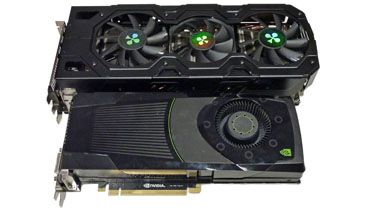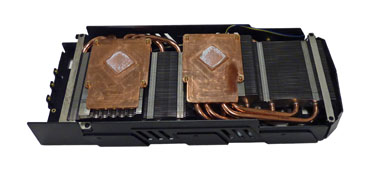Beastie Boy
There's been plenty of press and enthusiast brouhaha over the launch of the GeForce GTX TITAN graphics card last week. Now firmly installed as the world's fastest consumer GPU, while providing whisper-quiet operation and enviable power consumption, the flabbergasting £850 price tag elevates it to luxury status. As we noted in our review, there are faster (single-board) alternatives out there if performance is the primary concern.
One such card that can, in some games, effortlessly brush aside the TITAN is the partner-built AMD Radeon HD 7990. This card takes in two Radeon HD 7970 GPUs, CrossFires them internally, and provides electric performance in many of today's leading titles. But these juggernauts aren't without hindrances, however, as the twin GPUs and sheer brute cooling required makes many an HD 7990 noisy and thirsty for watts.
Underscored by a bunch of performance-related improvements in recent Catalyst drivers, along with a change in our graphics testing to newer, more-intensive titles, the big, brash, beefy benchmark behemoth is represented in today's review by Club3D.
Running two Radeon HD 7970s on one board requires some serious design and heavy-duty cooling. Whereas the competitor GeForce GTX 690 and TITAN cards exude refinement, sumptuous build quality, and best-in-class acoustics, the HD 7990 looks and feels as if it's fresh from Club3D's skunkworks. Here are some vital stats for you: 1,785g in weight; triple-slot form factor; 12.5in PCB; three 8-pin PCIe connectors; and over-the-top cooling. The gargantuan cooler consists of three fans - an 80mm unit in the middle flanked by two 92mm fans either side - and a large array of copper and aluminium lies underneath.
Graphics aficionados will likely discern that, outwardly at least, this is the same graphics monstrosity as the PowerColor Devil 13. The obvious similarities are borne from the fact that both firms source hardware from TUL Corporation, which also happens to be PowerColor's parent company. We've previously seen near-identical 'custom' cards from Club3D and PowerColor.
Covered on the rear by a card-wide heatsink that shields half of the 6GB of GDDR5 memory - 3GB allocated to each GPU - the relative size of the PCIe slot provides graphic indication of sheer heft of this beastie.
A better illustration of its manliness is evident when comparing it to a GeForce GTX 680, which is no shrinking violet itself. It's actually helpful that the trio of 8-pin PCIe connectors are located on the side, rather than the front of the card, as it otherwise wouldn't fit into many chassis. As it is, ensure you have a spare 330mm from the PCI plate to any obstructions near the hard-drive cage and be prepared to lose two adjacent PCIe slots. Labouring a point, not only is it wider than most cards, it is also taller, by some 25mm, but, let's be honest, you're hardly likely to house it in a small-form-factor system.
This HD 7990 sticks with a conventional high-end display layout by using dual-link DVI-D, single-link DVI-I, HDMI and two mini-DisplayPort. It's hard to miss the red button in the middle, pregnant with promise of extra performance through elevated clocks, but one key difference between this and the aforementioned PowerColor card is in the frequencies the two ship at.
Club3D runs the two underlying Tahiti XT GPUs at 900MHz, or 25MHz shy of the speed of a single-GPU board. Memory, meanwhile, matches the 5,500MHz on offer from a standalone HD 7970. Press the red button, which loads a second BIOS, and the GPU clocks up to 925MHz, representing a minor gain and effectively becoming two full-fat HD 7970s on one board. PowerColor's frequencies are more adventurous, clocking in at 925MHz/5,500MHz default and rising to an impressive 1,000MHz/5,500MHz when said red button is called into action.
A peek at the PCB shows that it's been a tall challenge to have two HD 7970 GPUs run in tandem, connected via a bridge chip that resides underneath the mid-PCB heatsink. Though no hard-and-fast numbers are available, the card's TDP is at least 300W, we imagine, perhaps closer to 350W. This is perhaps reason enough for Club3D not to consider the faster, thirstier, GPU-boosting Radeon HD 7970 GHz Edition as the blueprint for the two GPUs, because having two of those on one board would lead to a card that would require even-meatier cooling, a la ASUS ARES 2.
Those readers with ample cash to spend can hook another card up via the single CrossFire finger on the top-left, but do be aware that the supporting motherboard will need to have plenty of space between the active x16 PCIe slots.
A couple of Radeon HD 7970 cards currently cost £600, Club3D's card retails for around £750, meaning there's a 25 per cent premium for having the two GPUs on one board. Backed by a two-year warranty, which is upgraded to the manufacturer-direct, express Royal Service, the company also includes a support pod to help brace the card's near-2kg weight in the system. Potentially sweetening the deal somewhat, those who purchase the card from authorised retailers will be able to claim six free games under AMD's Never Settle Reloaded Bundle. We say potentially because, at the time of writing, this particular HD 7990 wasn't listed on the eight UK-approved retailers.
Let's now see if the HD 7990 can light a fire under the GeForce GTX 690 and TITAN.

















